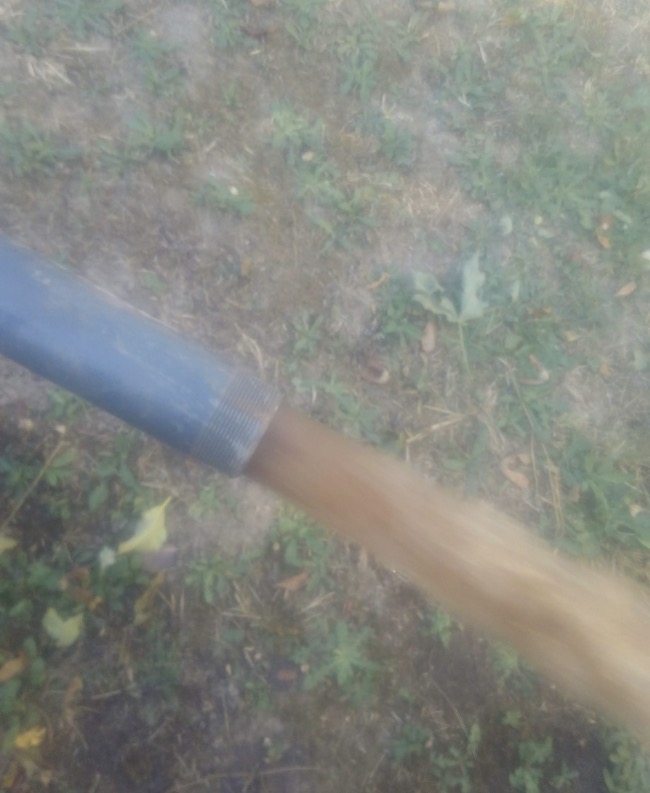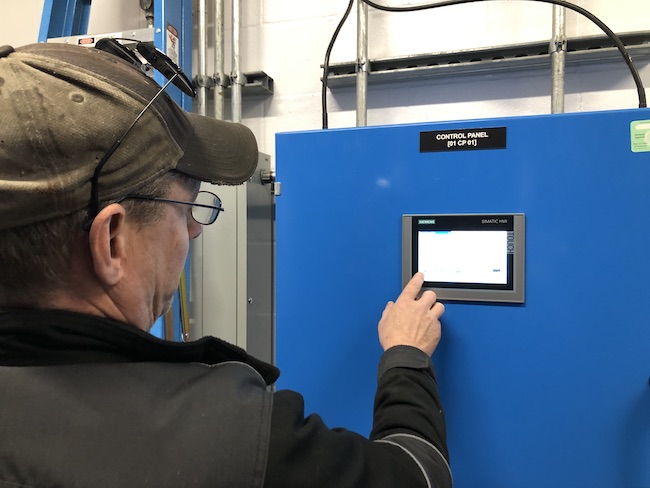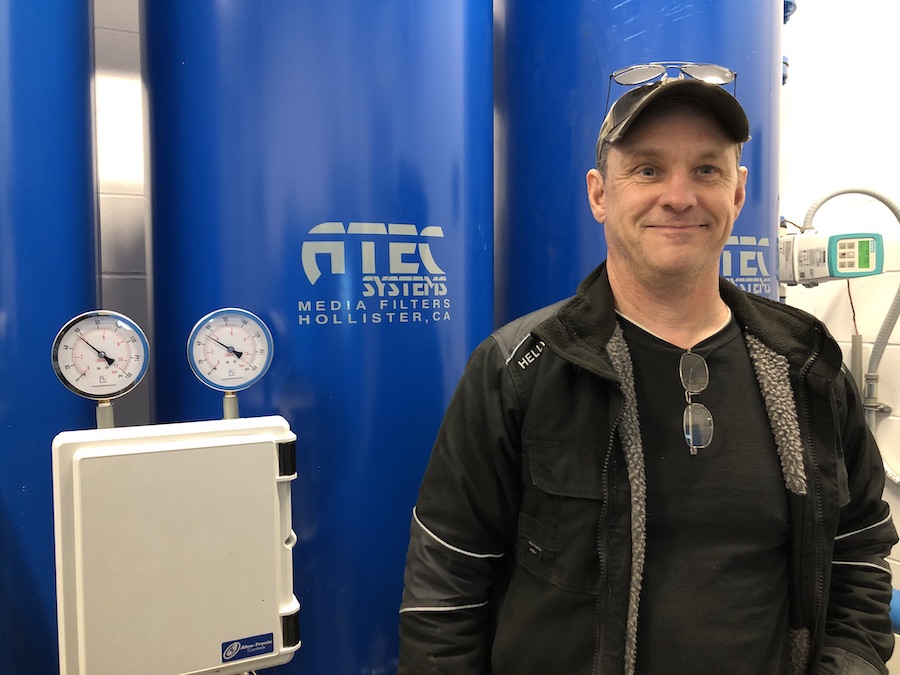This guest article is written by: Mary Bruno, Vashon Groundwater Protection committee member, as part of a series featuring important water topics on Vashon-Maury Islands. To access all articles in this series go to our blog page and type Mary Bruno into the search bar.
Dave Stoltz is used to the occasional customer complaint about a brownish tint to the water down in Dockton. But the summer of 2020 was different.
Stoltz manages the Dockton Water Association (DWA), one of Vashon-Maury’s seven large Group A water districts. That summer he was getting calls from customers who live up near DWA’s Sandy Shores well. “They were saying, ‘My water is almost black,’” Stoltz recalls. “And this is water coming out of their faucets, so that means there’s a lot of manganese being pumped out of that well. So I found a fire hydrant close by and I opened that puppy up. I’ve been here for eight and a half years now. I had never seen it that bad. The water was black.”

Credit: Dave Stoltz
The 475-foot Sandy Shores well is Dockton’s backup water source. The primary source is Dockton Springs, a field of 26 shallow (10-12 feet deep) well-points that together delivers, “Really clean, good-tasting water,” says Stoltz. “There’s a very shallow aquifer down there. It doesn’t matter how hot it is, or how wet it is. Those wells provide 80-85 gallons per minute, year-round.”
Dockton’s Sandy Shores well is even more productive than the Springs. But like most medium to deep wells on the Island, its water is high in iron and manganese. Stoltz used Sandy Shores sparingly—in summertime when demand peaked—and he always blended its water with the iron-and-manganese-free supply from the Springs. But higher summer temperatures have boosted demand. “We pumped a lot of water out of our Sandy Shores well that summer,” he says. The surge in volume flushed manganese that had collected in the pipes out into the system. And Dave Stoltz’s phone started ringing.
But that was then.
After the black water summer of 2020, DWA installed a new, state-of-the-art treatment plant to remove iron and manganese from its water supply. “We wanted to be able to use the Sandy Shores well full time to accommodate future growth, climate change, you can name a number of factors,” says Stoltz. So during the height of the pandemic Dockton Water invested $640,000 in a new filter assembly from California-based ATEC Systems, along with a new building to house it. “It is so basic,” says Stoltz. “Just these four steel canisters—two feet in diameter, six feet tall—filled with green sand and charcoal.” Manganese and iron adhere to the green sand, which is actually dark grey in color and looks like tiny beads of activated charcoal. Stoltz programmed the system to backwash itself once a day, flushing the trapped iron and manganese out of the sand and into a holding pond adjacent to the treatment building; and to activate the Sandy Shores pump whenever water levels in Dockton’s storage silos fall to 26 feet. “We brought the system on line in June of 2021, right in time for the summer rush,” says Stoltz. “And for the first time ever the silos stayed full all summer long.” (Silos are full at 38 feet.)

Credit: Mary Bruno
The new treatment system connects (via wireless) and coordinates the Springs and the Sandy Shores well. When levels in the silos dip too low, there’s a “call” for water. The Springs pump answers the call, sending water first into a “contact basin,” and then out to Dockton’s 408 customers and its storage silos. When the contact basin level gets too low—that takes about an hour of pumping—the Sandy Shores well kicks on. It stays on until the contact basin is full again, which takes another hour. The two water sources keep alternating in this way until there’s no call for water, meaning both contact basin and storage siloes are topped off. “Once I got that timing figured out it changed everything,” says Stoltz. “It’s been phenomenal.”
The new treatment system has effectively lowered manganese levels in Sandy Shores well water. A sample from 2019, before the treatment plant, showed manganese at 0.162 milligrams per liter (mg/L). Since the plant came online, says Stoltz, the manganese level, on average, has been 0.010mg/L. The new treatment system also raised Dockton’s operating overhead. It uses more electricity—mostly because the Sandy Shores well is now running more frequently—and a lot more chlorine. Stoltz is already working on ways to lower those costs, but when he weighs the plant’s benefit to public safety, and to his own peace of mind, some extra cost seems worth it.
Manganese is a naturally occurring element. It is present in nearly all of the Island’s medium to deep wells. Unlike Burton Water, whose supply doesn’t have high levels of manganese, most Vashon water districts deal with the mineral, one way or another. They treat (Maury Mutual and Dockton). They blend (Westside Water and Water District 19). They blend, but in emergencies only (Heights Water). The shallow spring well points and nearby deeper wells at Heights draw from a manganese-free aquifer. But Well 4 pulls from a deeper aquifer with higher concentrations of manganese, arsenic and ammonia. Thus its status as an “emergency-only” source. If needed, Well 4 water would be blended.
Officially, Washington’s Department of Health still considers manganese a “secondary contaminant”; that is, an aesthetic nuisance rather than a health risk. It stains sinks, faucets and shower heads. It’s hell on laundry. The current MCL (Maximum Contaminant Level) for manganese in the state and the country is 0.50mg/L. But that may change. A 2019 manganese update from the State DOH noted that manganese exposure from drinking water can lead to behavioral and neurological problems in infants and young children, and to an increased risk of Parkinson’s in seniors. Canada has lowered its MCL for manganese in drinking water. The DOH update advised water providers to, “Plan ahead for changes [to] source and . . . treatment”, and to, “Update publications to remove [the phrase] ‘manganese does not pose a threat to human health.’”
Dave Stoltz handled Dockton’s black water scare the old fashioned way back in the summer of 2020. “I flushed the heck out of a big part of the system and got rid of the manganese buildup in the pipes,” he says. With any luck, he won’t be dealing with that problem again.
Lead photo: Manager Dave Stoltz loves Dockton Water’s new manganese treatment plant.
Credit: Mary Bruno


Nicely done! These issues are endemic to shallow wells, as well. Our Group B well (135ft) has chronic iron and manganese issues that are being handled by greensand, chlorine,and carbon, a successful, if more expensive approach, but the “black and tan” is now confined to our Guiness and bitter.
So what happens to the effluent in the holding ponds? Where will it wind up?
Good question, Jim. I’m on it.
I emailed Dave Stoltz about the question Jim Garrison posed above: “What happens to the [manganese-rich] effluent in the holding ponds?”
“The manganese collects in the pond,” Dave wrote. “At some point, we will probably have to dig the buildup out.” The timetable and process for that are “TBD.”
Great article, always nice to learn more about our water systems and island geology. Thank you!